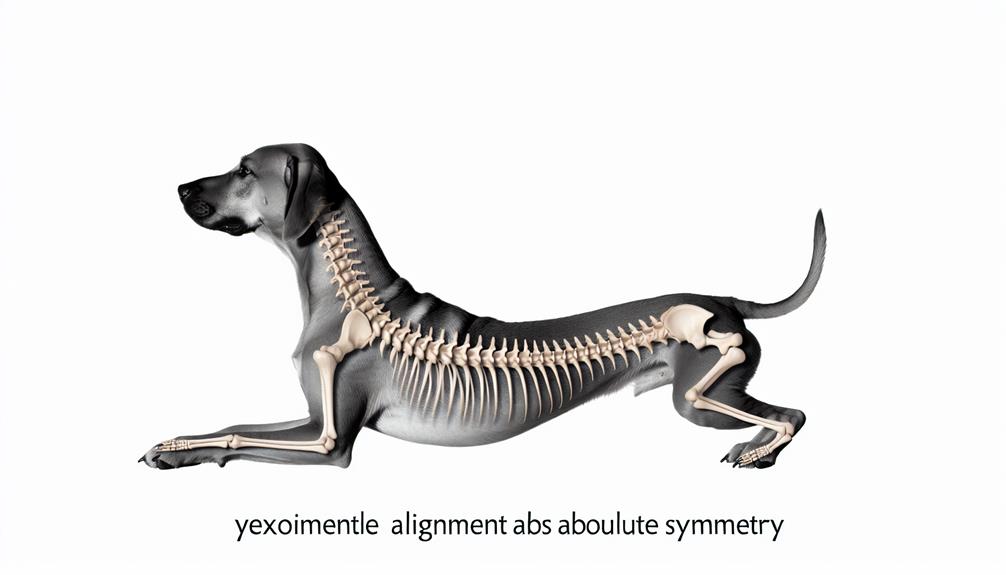
13 Feb Why Is Natural Spinal Alignment Important for Dogs?
Did you know that natural spinal alignment plays a crucial role in the overall health of dogs? Think about it this way: just like humans, dogs rely on their spine to support their body and facilitate movement.
When their spine is properly aligned, it allows for efficient communication between their brain and body, ensuring optimal functioning of the nervous system. But what happens when a dog's spine is misaligned? How does it affect their mobility and overall well-being?
In this discussion, we will explore the importance of natural spinal alignment for dogs and why prioritizing it is vital for their health and longevity. Stay tuned to discover the impact of spinal alignment on a dog's nervous system and learn tips for maintaining their spinal health.
The Role of Spinal Alignment in Dog's Overall Health
Why is natural spinal alignment important for your dog's overall health and well-being? Proper spinal alignment plays a crucial role in the overall health of your beloved pet. The musculoskeletal system, which includes the spine, is responsible for supporting the body's structure and facilitating movement. When the spine is misaligned, it can lead to pain, discomfort, and reduced mobility in dogs. By maintaining natural spinal alignment, you can help prevent musculoskeletal issues and support optimal posture in your dog.
Furthermore, spinal alignment affects the nervous system, which is responsible for transmitting signals throughout the body. The central nervous system relies on the spine to protect and support the delicate nerves that control various bodily functions. When the spine is misaligned, it can interfere with proper nerve function, leading to a range of health problems in dogs.
Additionally, proper spinal alignment promotes better circulation in your pet. This improved blood flow helps deliver essential nutrients to the body's tissues while aiding in the removal of waste products. By ensuring that your dog's spine is in alignment, you can support their overall health and well-being.
How Spinal Alignment Affects a Dog's Movement and Agility
Proper spinal alignment in dogs enhances their movement efficiency and agility, allowing for smoother and more coordinated physical activities. When a dog's spine is correctly aligned, the nervous system can function optimally, facilitating the flow of messages between the brain and muscles. This optimal nerve function enables precise movements and coordination, which are essential for agility and athletic performance.
Misalignments in the spine can lead to decreased flexibility and range of motion, hindering a dog's ability to perform physical activities effectively. These misalignments, also known as subluxations, can result in trapped nerves and abnormalities in the alignment of the musculoskeletal system. Such abnormalities can create pressure and tension on the nerves, leading to pain, reduced range of motion, and compromised performance.
Canine chiropractic care, a branch of veterinary chiropractic, focuses on restoring proper spinal alignment in dogs. By utilizing gentle and specific adjustments, chiropractors can help relieve pressure on the nerves and correct misalignments in the spine. This promotes better movement and agility in dogs, reducing the risk of injury during high-impact activities or sudden movements.
Maintaining natural spinal alignment in dogs is crucial for their overall musculoskeletal health. It supports their long-term mobility and quality of life. By ensuring proper spinal alignment, dogs can enjoy improved movement efficiency, enhanced agility, and a reduced risk of injury, allowing them to lead active and fulfilling lives.
The Impact of Natural Spinal Alignment on a Dog's Nervous System
Maintaining natural spinal alignment in dogs is essential for optimal nervous system function, allowing for efficient communication between the brain and the rest of the body. The spinal cord plays a crucial role in transmitting signals to and from the brain, controlling body movements and organ functions. Misalignments in the spine can compress nerves, disrupting communication and potentially causing pain, weakness, or dysfunction. By ensuring natural spinal alignment, pet owners can help preserve proper nerve conduction, facilitating the transmission of sensory information and motor commands throughout their dog's body.
A healthy spine supports a healthy nervous system, enabling quick and accurate responses to stimuli, coordination of movements, and regulation of bodily processes in dogs. When the spine is misaligned, nerve conduction may be compromised, leading to a variety of issues. Chiropractic treatment can help realign the spine, relieving pressure on nerves and restoring proper communication within the nervous system.
Promoting natural spinal alignment contributes to overall health and quality of life for dogs. It can help alleviate pain, improve mobility, and enhance the dog's ability to perform daily activities. By prioritizing their dog's spinal alignment, pet owners can ensure optimal nervous system function, leading to a happier and healthier canine companion.
Common Issues Caused by Misaligned Spines in Dogs
When the spine of a dog becomes misaligned, it can lead to a range of common issues caused by nerve compression, resulting in pain, discomfort, and potential mobility problems. Here are some of the common problems that can arise from misaligned spines in dogs:
- Limping: Misaligned spines can cause dogs to limp or favor one leg over another.
- Difficulty rising: Dogs with misaligned spines may struggle to get up from a lying or sitting position.
- Reluctance to move: Misalignments can make dogs hesitant to engage in physical activity or play.
- Changes in gait: Dogs may exhibit changes in their walking or running patterns due to misaligned spines.
These musculoskeletal problems not only affect a dog's physical well-being but can also impact their overall quality of life. Untreated misalignments can lead to muscle atrophy, decreased range of motion, and decreased enjoyment of daily activities. Additionally, misaligned spines may contribute to behavioral changes, such as aggression, irritability, or changes in appetite.
Regular chiropractic treatments can help prevent and address misalignments in dogs, promoting overall health and well-being. By maintaining proper spinal alignment, dogs can experience improved mobility, reduced pain, and enhanced quality of life.
Stay tuned for the next subtopic, where we'll discuss tips for maintaining natural spinal alignment in dogs.
Tips for Maintaining Natural Spinal Alignment in Dogs
To ensure your dog's spinal alignment remains natural and healthy, it's important to implement certain strategies and practices. The musculoskeletal system plays a vital role in maintaining spinal alignment, and regular exercise is key in supporting this. Engaging your dog in physical activities such as walking, running, and playing fetch helps strengthen the muscles that surround the spine, promoting proper posture and reducing the risk of misalignments.
In addition to exercise, a nutritious diet is crucial for spinal health. Providing a balanced diet rich in essential nutrients supports bone and muscle growth, ensuring a strong and healthy spine. Avoiding excessive jumping or high-impact activities is also important, especially for breeds prone to musculoskeletal issues. These activities can put excessive strain on the spine, leading to injuries and misalignments.
Supportive bedding and comfortable resting areas are another important factor in maintaining natural spinal alignment. Providing your dog with a bed that offers adequate support and cushioning helps reduce strain on the back, promoting proper alignment during rest.
Regular veterinary check-ups and preventive care are essential for monitoring your dog's spine. Your veterinarian can assess your dog's spinal alignment and recommend chiropractic adjustments if necessary. Chiropractic care can help correct misalignments and ensure the spine stays healthy.







No Comments